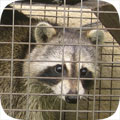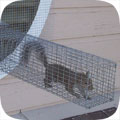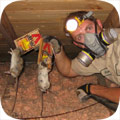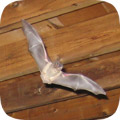- st.louispark@wildlifeanimalcontrol.com
Call 24/7 for a free quote:
952-232-4393
St. Louis Park Wildlife Animal Control
Professional Wildlife Removal Company Servicing St. Louis Park, MN
If you have a problem with wildlife in your St. Louis Park home, your best option is to hire a company that specializes in Minnesota wildlife removal only. This is a specialty business, and regular pest control companies do not use the proper techniques to solve animal problems. I have spent many years reviewing Minnesota and St. Louis Park, and I recommend the following:
Professional Wildlife Removal St. Paul
Cell Phone: 952-232-4393
NOTE: If you have a dog or cat problem, call Hennepin County Animal Services: 952-924-2618

Professional Wildlife Removal St. Paul specializes primarily in removing animals from attics of homes and buildings - this includes squirrels in attics, raccoons, and rats or mice in homes. Minnesota also has a documented problem with
bats in buildings, and Professional Wildlife Removal St. Paul is specially trained in bat removal. They also perform general wildlife trapping services, such as the capture and removal of skunks or opossums on the
property. Call 952-232-4393 to discuss your critter problem and schedule a same-day or next-day appointment. Click here to learn more about what prices we charge in 2020.
When hiring a company to solve your wild animal problem, you want these features:
- Specializes in wildlife removal, not pest control
- Fully Minnesota and Hennepin County licensed and insured
- Works 7 days per week (critters don't take weekends off)
- Performs full building inspections: enters and inspects attic
- Performs exclusion repairs, with guarantee against animal re-entry
- Offers cleanup of biohazardous wildlife waste
Professional Wildlife Removal St. Paul is a full-service St. Louis Park wildlife removal company. This is very different from a regular St. Louis Park pest control company. The pest control companies spray poison to kill insects. This is not at all
similar to wildlife removal. Professional Wildlife Removal St. Paul performs a full inspection of the home or property, and determines why the animal(s) are there, and if inside a building, how the animals got inside. All
animals (including rodents) are trapped and removed, or if possible, removed from the building using special exclusion devices. Once the animals are gone, preventative repairs are essential, and
cleanup is sometimes recommended.
 St. Louis Park wildlife trapping - it's not as simple as it may seem. It's illegal in Minnesota to trap without a license. Trap type is very important and there are many different types, bait is somewhat relevant, trap placement
is vital, and there are dozens of small things that are very important to know.
Safety is a concern. Then once the animal is trapped, it must be removed and dealt with in the proper manner according to Minnesota law. We offer St. Louis Park raccoon removal. Read more about how to get rid of raccoons.
St. Louis Park wildlife trapping - it's not as simple as it may seem. It's illegal in Minnesota to trap without a license. Trap type is very important and there are many different types, bait is somewhat relevant, trap placement
is vital, and there are dozens of small things that are very important to know.
Safety is a concern. Then once the animal is trapped, it must be removed and dealt with in the proper manner according to Minnesota law. We offer St. Louis Park raccoon removal. Read more about how to get rid of raccoons.
 Animals in attics - this is our specialty at Professional Wildlife Removal St. Paul. Many types of animals like to live in attics. This includes squirrels, raccoons, rats, mice, bats, birds, and even possums. Critters like to go into attics for a safe place to live
and raise their young. Removing animals from attics is very complex work, partly because of the presence of baby animals. If you need St. Louis Park squirrel removal, we can remove all the squirrels from your attic, and seal out any future ones. Read more about how to get rid of squirrels.
Animals in attics - this is our specialty at Professional Wildlife Removal St. Paul. Many types of animals like to live in attics. This includes squirrels, raccoons, rats, mice, bats, birds, and even possums. Critters like to go into attics for a safe place to live
and raise their young. Removing animals from attics is very complex work, partly because of the presence of baby animals. If you need St. Louis Park squirrel removal, we can remove all the squirrels from your attic, and seal out any future ones. Read more about how to get rid of squirrels.
 Rodent control must be done in a very specific way. First off, the most important thing is that all the openings that rats and mice can use to enter a house be sealed. Then all the rodents must be physically trapped and removed.
Never, ever use poison! Most St. Louis Park exterminators will just use this lazy poison technique to kill rodents, and it causes more harm than good - dead stinky rats, and it doesn't solve the problem. Call us for correct St. Louis Park rat removal. Read more about how to get rid of rats.
Rodent control must be done in a very specific way. First off, the most important thing is that all the openings that rats and mice can use to enter a house be sealed. Then all the rodents must be physically trapped and removed.
Never, ever use poison! Most St. Louis Park exterminators will just use this lazy poison technique to kill rodents, and it causes more harm than good - dead stinky rats, and it doesn't solve the problem. Call us for correct St. Louis Park rat removal. Read more about how to get rid of rats.
 Bat removal is a highly specialized task. Minnesota is known to have colonizing bats who often live in buildings. Bats love attics. If not removed, the colony can grow to a very large size over the years. The bat droppings are often corrosive and
cause health risks. The same goes for bird droppings on or in buildings. We perform St. Louis Park pigeon removal and bird control. But our specialty is St. Louis Park bat removal. We remove 100% of the bat colony and seal the building so that it's totally bat-proof. Read more about how to get rid of bats.
Bat removal is a highly specialized task. Minnesota is known to have colonizing bats who often live in buildings. Bats love attics. If not removed, the colony can grow to a very large size over the years. The bat droppings are often corrosive and
cause health risks. The same goes for bird droppings on or in buildings. We perform St. Louis Park pigeon removal and bird control. But our specialty is St. Louis Park bat removal. We remove 100% of the bat colony and seal the building so that it's totally bat-proof. Read more about how to get rid of bats.
 If you have animals inside a house, no job is complete without proper exclusion repairs. If you simply hire a St. Louis Park trapper who only removes the critters, then the problem will return. You need to hire a St. Louis Park wildlife control company that identifies 100% of the animal entry points
into your building, and seals them shut with professional repairs. In addition, in many cases animals have left waste or contamination behind, and you'll want a company that can provide professional cleaning services. Professional Wildlife Removal St. Paul does both.
If you have animals inside a house, no job is complete without proper exclusion repairs. If you simply hire a St. Louis Park trapper who only removes the critters, then the problem will return. You need to hire a St. Louis Park wildlife control company that identifies 100% of the animal entry points
into your building, and seals them shut with professional repairs. In addition, in many cases animals have left waste or contamination behind, and you'll want a company that can provide professional cleaning services. Professional Wildlife Removal St. Paul does both.
The above are just some of the services offered by Professional Wildlife Removal St. Paul. We also trap and remove animals that destroy lawns, such as moles, or digging animals. Sometimes animals like opossums will live under buildings, steal pet food, raid garbage cans, etc.
Read about how to get rid of opossums. Skunks commonly live under sheds or decks, and set up a den. We can trap and remove them without them spraying. Read about how to get rid of skunks. Professional Wildlife Removal St. Paul
also provides dead animal removal in St. Louis Park. If you need help with any other wildlife conflict, from a fox, beaver, groundhog, or any other critter, we can solve it. We also do St. Louis Park snake removal - most of the snakes in Minnesota are not venomous, but
call us if you want safe removal, or read about how to get rid of snakes in St. Louis Park. And remember, we are a private business, not Hennepin County Animal Control Services, so if you have a dog or cat problem, call the County at 952-924-2618.
Hennepin County animal services does not handle any wildlife issues.
Professional Wildlife Removal St. Paul: 952-232-4393
St. Louis Park Pricing Info For Year 2020
 Every wildlife removal situation is different, from the species of animals involved, the location of the animal inside a house or outside, the extent of repairs or cleanup, etc. It's impossible to give one-size-fits-all prices. Examples MIGHT include:
Every wildlife removal situation is different, from the species of animals involved, the location of the animal inside a house or outside, the extent of repairs or cleanup, etc. It's impossible to give one-size-fits-all prices. Examples MIGHT include:
Small Job: For example, a one-stop job to remove an animal in the yard: $100 on up
Medium Job: For example, getting critters out of your house with minor repairs: $300 on up
Large Job: For example, a project involving many service trips and complex work: $500 on up
Give us a phone call now and tell us about your wildlife issue and we will be able to give you a price estimate over the phone. If you're cool with it, we can schedule a same-day or next-day appointment if you like. Our prices are fair, and a good value because we do the job right, the first time.
St. Louis Park Wildlife Tip #1:
What diseases do armadillos carry?
The armadillo is a small mammalian animal, terrestrial and omnivorous, a very interesting species due to its figure, ears, nose, and shell are elements that distinguish it from other rodents. Armadillos, mammals that are characterized by an armor that covers their organisms through different layers, have the ability to infect humans with many diseases.
As per the recent study, armadillo carries the bacteria that cause leprosy and that somehow transmitted the disease to numerous dozen human beings in the southern US.
Although it is considered an eradicated disease, traces of the bacterium Mycobacterium leprae can still be found which after a considerable period of gestation affects the peripheral nerves, the skin, the respiratory system, the eyes and the soft tissue of the nose. It is transmitted by coughing or sneezing and since the bacteria affects the nerves, there is a loss of sensation, the muscles weaken and then paralyze, which can lead to amputation.
Let us find out about what diseases do armadillos carry?
Leprosy:
Leprosy is a disease caused by a bacterium that causes progressive lesions to the skin, nerves, and extremities. The most common forms of infection are through nasal and oral fluids such as saliva. The hunting of armadillos is also linked to the spread of leprosy.
A new study published that some of these animals carry the disease, causing skin lesions, nerves, and limbs.
Rabies:
A small amount of armadillos carries rabies and this disease can be transmitted to a human by a bite or a scratch from this animal. Armadillos are very much cautious and very much quick to react. If you will try to catch it, they may bite you or they may give you injuries with its scratch that can be the reason to transmit rabies.
Salmonella:
Salmonella is one of the diseases that are found in various types of animal. This disease can be easily transmitted into a human through the human food chain if water or food is contaminated by armadillos. This disease can cause severe symptoms such as vomiting and significant diarrhea. It can be deadly in many cases if it is infected with elderly people, children, or those with a vulnerable immune system.
These mammals, in addition to humans, are the only animals that can contract this disease and the study reports that leprosy can be acquired by eating their meat, being exposed to the land where they make their burrows or by direct contact, as in hunting.
St. Louis Park Wildlife Tip #2:
Minnesota Wildlife Information:
Minnesota State bird: Common loon
State mammal: Black bear
State amphibian: Northern leopard frog
State fish: Walleye
State insect: Monarch butterfly
Minnesota is known as "the land of 10,000 lakes", which is a correct description of the glacial-carved landscape. In reality, the state has over 11,000 lakes. The large bodies of water are supported collectively by over 6,000 streams. The water doesn't stop there; there are over 10 million acres of wetlands in the region. Despite being one of the more populated states in the country, over 60 percent of Minnesota's population lives in the Minneapolis-Saint Paul metropolitan area. This leaves much of the south as farmland and much of the north as unpopulated forest known as the North Woods.
Aquatic and semi-aquatic animals thrive in this land of 10,000 lakes. There are numerous beavers, muskrats, and otters. These are only a few of the animals that like to live in wetlands, and one of the most common nuisance animals in the state-the raccoon-is also a fan of such a location. Raccoons are not strict forest dwellers. They will live anywhere they can find a vertical surface to climb if danger approaches. The appeal of a swamp or lake for a raccoon is the abundance of reptile and bird nests that can be raided for tasty eggs.
While a good portion of the state is water-oriented, there are many areas where deciduous forests were cleared for farmland. These vast expanses of land combined with the natural prairie of the state support herds of bison, elk, and caribou. All of these large grazers have been severely affected by conversion of plains into farmland, and now numbers of each animal are minimal. More solitary grazers like the moose tend to fare better in the second-growth forests around the state. There is also an abundance of white-tailed deer which keep local packs of timber wolves fed.
Minnesota has the largest population of timber wolves in the country second only to Alaska. These wolves are usually reclusive, but harsh weather can drive them toward farms in search of grazing livestock. More problematic for people are the coyotes, which cannot compete with the wolves for food, and often rely on sneaky tactics to secure a meal from the local farmhouse.
Common animals in the state are skunks, gophers, squirrels, porcupines, foxes, salamanders, snakes, black bear, bobcats, cougars, and bald eagles.
You can always call Professional Wildlife Removal St. Paul, any time of day, at 952-232-4393, for a price quote for St. Louis Park wildlife control services. I am confident that this is the best choice amongst wildlife removal companies in St. Louis Park, MN.





































